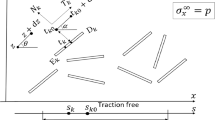Abstract
In the present work, we study cracklike defects of various types within the framework of the linearized theory of elasticity for bodies with initial stresses suggested by Guz'. Our approach is based on the solution of the problem of the plane region of discontinuity of displacements and stresses in preliminarily stressed bodies. By using the method of Fourier integral transformations, we construct singular integral equations for cracks with arbitrarily loaded lips and for rigid and elastic inclusions. The exact solutions of the corresponding integral equations are obtained for various types of loading. As a result, we determine the influence of preliminary deformation along plane defects on the stressed state in their vicinity.
Similar content being viewed by others
References
A. N. Guz',Mechanics of Brittle Fracture of Materials with Initial Stresses [in Russian], Naukova Dumka, Kiev (1983).
V. V. Panasyuk,Limiting Balance of Brittle Bodies with Cracks [in Russian], Naukova Dumka, Kiev (1969).
V. V. Panasyuk, M. M. Stadnik, and V. P. Sylovanyuk,Stress Concentration in Three-Dimensional Bodies with Thin Inclusions [in Russian], Naukova Dumka, Kiev (1986).
Additional information
Karpenko Physicomechanical Institute, Ukrainian Academy of Sciences, L'viv. Translated from Fiziko-Khimicheskaya Mekhanika Materialov, Vol. 31, No. 2, pp. 22–35, March – April, 1995.
Rights and permissions
About this article
Cite this article
Sylovanyuk, V.P. Cracks and cracklike defects in the preliminarily stressed body. Mater Sci 31, 170–183 (1996). https://doi.org/10.1007/BF00558636
Received:
Issue Date:
DOI: https://doi.org/10.1007/BF00558636




